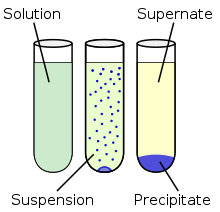Precipitation

Precipitation is the creation of a solid in a solution or inside another solid during a chemical reaction or by diffusion in a solid. When the reaction occurs in a liquid solution, the solid formed is called the ‘precipitate’.The chemical that causes the solid to form is called the ‘precipitant’. Without sufficient force of gravity (settling) to bring the solid particles together, the precipitate remains in suspension. After sedimentation, especially when using a centrifuge to press it into a compact mass, the precipitate may be referred to as a ‘pellet’. The precipitate-free liquid remaining above the solid is called the ‘supernate’ or ‘supernatant’. Powders derived from precipitation have also historically been known as ‘flowers’.
Sometimes the formation of a precipitate indicates the occurrence of a chemical reaction. If silver nitrate solution is poured into a solution of sodium chloride, a chemical reaction occurs forming a white precipitate of silver chloride. When potassium iodide solution reacts with lead nitrate solution, a yellow precipitate of lead iodide is formed.
Precipitation may occur if the concentration of a compound exceeds its solubility (such as when mixing solvents or changing their temperature). Precipitation may occur rapidly from a super saturated solution.
In solids, precipitation occurs if the concentration of one solid is above the solubility limit in the host solid, due to e.g. rapid quenching or ion implantation, and the temperature is high enough that diffusion can lead to segregation into precipitates. Precipitation in solids is routinely used to synthesize nanoclusters.
An important stage of the precipitation process is the onset of nucleation. The creation of a hypothetical solid particle includes the formation of an interface, which requires some energy based on the relative surface energy of the solid and the solution. If this energy is not available, and no suitable nucleation surface is available, supersaturation occurs.

